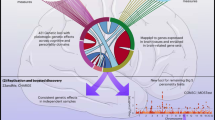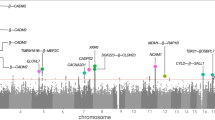Abstract
Transcription factor AP-2β is implicated in playing an important role during embryonic development of different parts of the brain, eg, midbrain, hindbrain, spinal cord, dorsal and cranial root ganglia.1, 2 The gene encoding AP-2β contains a polymorphic region which includes a tetranucleotide repeat of [CAAA] four or five times, located in intron 2 between nucleotides 12593 and 12612.3 Since the midbrain contains structures important for variables such as mood and personality, we have investigated if the AP-2β genotype is associated with personality traits estimated by the Karolinska Scales of Personality (KSP). Identification of transcription factor genes as candidate genes in psychiatric disorders is a novel approach to further elucidate the genetic factors that, together with environmental factors, are involved in the expression of specific psychiatric phenotypes. The AP-2β genotype and KSP scores were determined for 137 Caucasian volunteers (73 females and 64 males). The personality traits muscular tension, guilt, somatic anxiety, psychastenia and indirect aggression were significantly associated with the specific AP-2β genotype, albeit with significant difference between genders. Based on this result the human AP-2β gene seems to be an important candidate gene for personality disorders. Moreover, the present results suggest that the structure of the intron 2 region of the AP-2β gene is one factor that contributes to development of the constitutional component of specific personality traits.
This is a preview of subscription content, access via your institution
Access options
Subscribe to this journal
Receive 12 print issues and online access
$259.00 per year
only $21.58 per issue
Buy this article
- Purchase on Springer Link
- Instant access to full article PDF
Prices may be subject to local taxes which are calculated during checkout
Similar content being viewed by others
References
Mitchell PJ, Timmons PM, Herbert JM, Rigby PW, Tjian R . Transcription factor AP-2 is expressed in neural crest lineages during mouse embryogenesis Genes & Dev 1991; 5: 105–119
Moser M, Rüschoff J, Buettner R . Comparative analysis of AP-2α and AP-2β gene expression during murine embryogenesis Dev Dyn 1997; 208: 115–124
Moser M, Pscherer A, Roth C, Becker J, Mücher G, Zerres K et al. Enhanced apoptotic cell death of renal epithelial cells in mice lacking transcription factor AP-2β Genes & Dev 1997; 11: 1938–1948
Williams T, Admon A, Luscher B, Tjian R . Cloning and expression of AP-2, a cell-type-specific transcription factor that activates inducible enhancer elements Genes & Dev 1988; 2: 1557–1569
Moser M, Pscherer A, Imhof A, Bauer R, Kerscher M, Amselgruber W et al. Cloning and characterisation of a second AP-2 transcription activator gene, AP-2β Development 1995; 121: 2779–2788
Oulad-Abdelghani M, Bouillet P, Chazaud C, Dollé P, Chambon P . AP-2.2: a novel AP-2 related transcription factor induced by retinoic acid during differentiation of P19 embryonal carcinoma cells Exp Cell Res 1996; 224: 338–347
Chazaud C, Oulad-Abdelghani M, Bouillet P, Décimo D, Chambon P, Dollé P . AP-2.2, a novel gene related to AP-2, is expressed in the forebrain, limbs and face during mouse embryogenesis Mech Dev 1996; 54: 83–94
Williams T, Tjian R . Analysis of the DNA-binding and activation properties of the human transcription factor AP-2 Genes & Dev 1991; 5: 670–682
Williams T, Tjian R . Characterization of a dimerization motif in AP-2 and its function in heterologous DNA binding proteins Science 1991; 251: 1067–1071
Bosher JM, Totty NF, Hsuan JJ, Williams T, Hurst HC . A family of AP-2 proteins regulates c-erbB-2 expression in mammary carcinoma Oncogene 1996; 13: 1701–1707
Roesler WJ, Vandenbark GR, Hanson RW . Cyclic AMP and the induction of eukaryotic gene transcription J Biol Chem 1988; 263: 9063–9066
Kobayashi K, Kurosawa Y, Fujita K, Nagatsu T . Dopamine β-hydroxylase gene: two mRNA types having different 3′-terminal regions are produced through alternative polyadenylation Nucleic Acids Res 1989; 17: 1089–1102
Greco D, Zellmer E, Zhang Z, Lewis E . Transcription factor AP-2 regulates expression of the dopamine β-hydroxylase gene J Neurochem 1995; 65: 510–516
McMahon M, Sabban E . Regulation of expression of dopamine β-hydroxylase in PC12 cells by glucocorticoids and cyclic AMP analogues J Neurochem 1992; 59: 2040–2047
Healy DP, O'Rourke DA . Regulation of dopamine-1A (DIA) receptor gene transcription Clin Exp Hypertens 1997; 19: 1–13
Hahn SL, Hahn M, Kang UJ, Joh TH . Structure of the rat aromatic L-amino acid decarboxylase gene: evidence for an alternative promoter usage J Neurochem 1993; 60: 1058–1064
Bradely CC, Blakely RD . Alternative splicing of the human serotonin transporter gene J Neurochem 1997; 69: 1356–1367
Du YL, Wilcox BD, Teitler M, Jeffrey JJ . Isolation and characterization of the rat 5-hydroxitryptamine type 2 receptor promoter: constitutive and inducible activity in myometrial smooth muscle cells Mol Pharmacol 1994; 45: 1125–1131
Quirin-Stricker C, Mauvais C, Schmitt M . Transcriptional activation of human choline acetyltransferase by AP2- and NGF-induced factors Mol Brain Res 1997; 49: 165–174
Baskin F, Li Y-P, Hersh LB, Davis RM, Rosenberg RN . An AP-2 binding sequence within exon 1 of human and porcine choline acetyltransferase genes enhances transcription in neural cells Neuroscience 1997; 76: 821–827
Stallings MC, Hewitt J-K, Cloninger CR, Heath AC, Eaves LJ . Genetic and environmental structure of the tridimensional personality questionnaire: three or four temperament dimensions J Person Social Psychol 1996; 70: 127–140
Watson D, Clark LA . Negative affectivity: the disposition to experience aversive emotional states Psychol Bull 1984; 96: 465–490
Helleday J, Edman G, Rietzen EM, Siwers B . Personality characteristics and platelet MAO activity in women with congenital adrenal hyperplasia (CAH) Psychoneuroendocrinology 1993; 18: 343–354
Hartmann J, Kunig G, Riederer P . Involvement of transmitter systems in neuropsychiatric diseases Acta Neurol Scand Suppl 1993; 146: 18–21
Perneger TV . What's wrong with Bonferroni adjustments BMJ 1998; 316: 1236–1238
Schalling D, sberg M, Edman G, Oreland L . Markers for vulnerability to psychopathology: temperament traits associated with platelet MAO activity Acta Psychiatr Scand 1978; 76: 172–182
Bassam BJ, Caetano-Anollés G, Gresshof PM . Fast and sensitive silver staining of DNA in polyacrylamide gels Anal Chem 1991; 196: 80–83.
Acknowledgements
This study was supported by grants from the Swedish Medical Research Council (No. 4145).
Author information
Authors and Affiliations
Corresponding author
Rights and permissions
About this article
Cite this article
Damberg, M., Garpenstrand, H., Alfredsson, J. et al. A polymorphic region in the human transcription factor AP-2β gene is associated with specific personality traits. Mol Psychiatry 5, 220–224 (2000). https://doi.org/10.1038/sj.mp.4000691
Received:
Revised:
Accepted:
Published:
Issue Date:
DOI: https://doi.org/10.1038/sj.mp.4000691
Keywords
This article is cited by
-
Association between Transcription Factor AP-2B genotype, obesity, insulin resistance and dietary intake in a longitudinal birth cohort study
International Journal of Obesity (2019)
-
Microsatellite polymorphisms associated with human behavioural and psychological phenotypes including a gene-environment interaction
BMC Medical Genetics (2017)
-
Does the transcription factor AP-2β have an impact on the genetic and early environmental influence on ethanol consumption?
Journal of Neural Transmission (2010)
-
Transcription factor AP-2β genotype and psychosocial adversity in relation to adolescent depressive symptomatology
Journal of Neural Transmission (2009)
-
Transcription factor AP-2 and monoaminergic functions in the central nervous system
Journal of Neural Transmission (2005)



